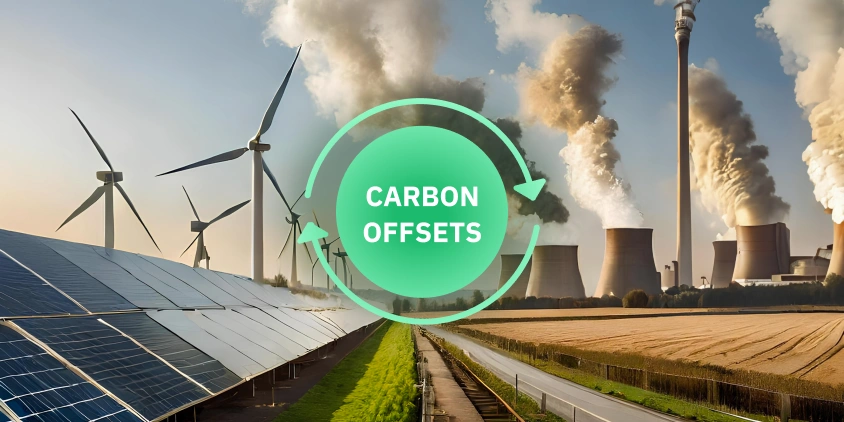
Carbon Offsets: Balancing Out Negative Eco-Footprint
To combat climate change, we must all do our part. And for those who can’t reduce their emissions directly, carbon offsets have emerged as their way to make a difference. This enables companies, NGOs, and governments to neutralize their negative environmental footprints by investing in projects that reduce greenhouse gas emissions. The range of compensation projects is vast and diverse, from reforestation efforts and regenerative agriculture to waste management. In this carbon offset guide, you’ll learn what they are, how they work, and which types of projects you might choose from in the global battle against climate change.
What Is A Carbon Offset?
A carbon offset can refer to either the credit or the process of compensating for one’s environmental footprint. The general idea is to either lower emissions of greenhouse gases (GHGs) or increase sequestration elsewhere to balance out ones emissions. Carbon offset credits are marketable financial products that have been independently validated by certifying bodies or government agencies. Anyone buying this instrument can use the underlying emission decrease to meet their own greenhouse gas targets. Purchasing GHG offsets typically (but not necessarily) results in funding for green initiatives.
Imagine a steel plant aiming to cut down on GHG emissions. Instead of waiting decades for low-emission technologies to become feasible for them, they could buy credits, for example, from large-scale reforestation projects to start lowering emissions right away.
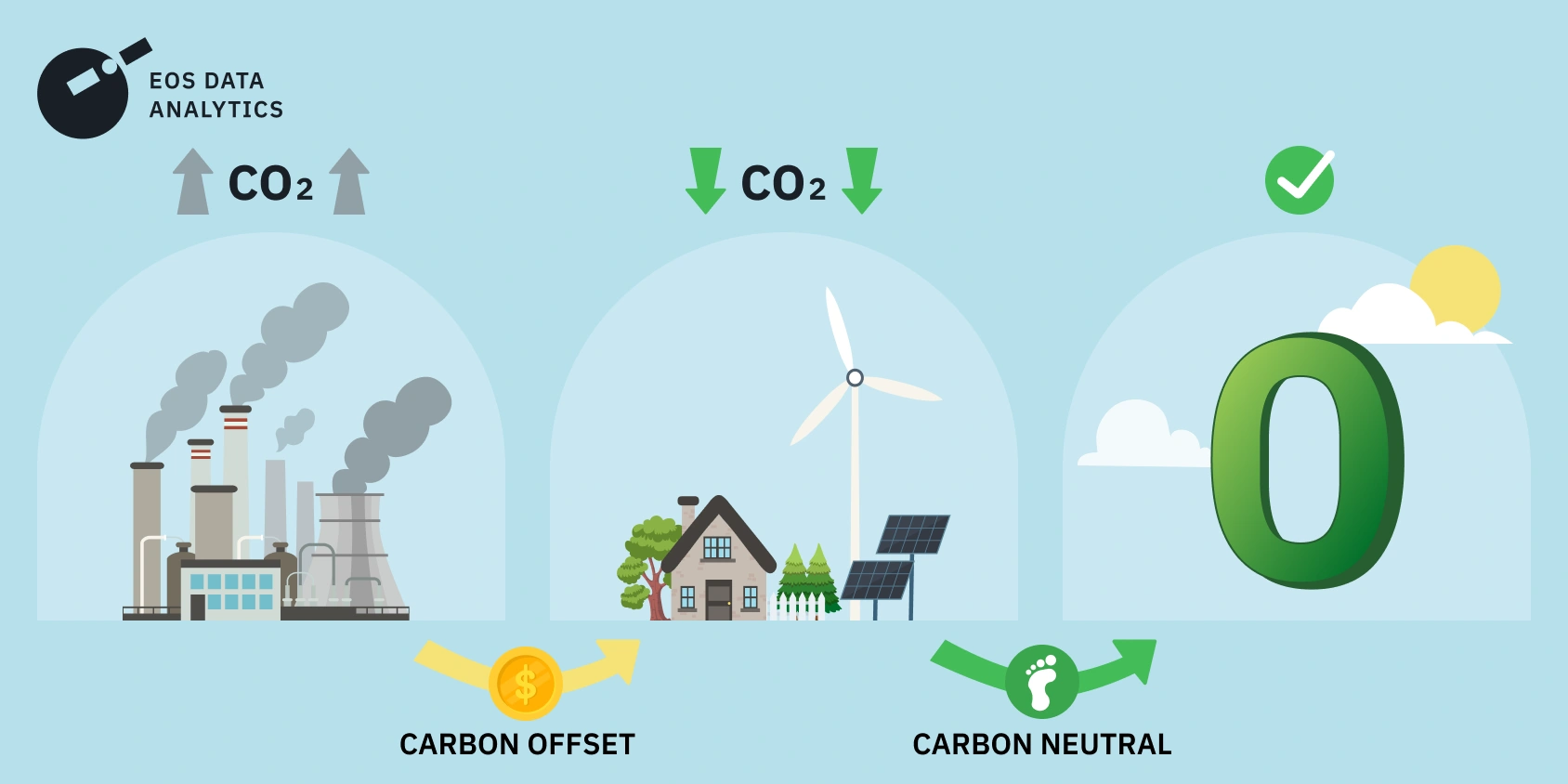
How Do Carbon Offsets Work?
The following is a simple example to help you grasp the typical flow of offsetting carbon emissions:
- A company generates some CO2 emissions it can’t reduce.
- A broker assesses these emissions and charges the corresponding fee, allowing the company to balance out its footprint.
- A renewable energy project receives part of the fee that the company pays.
- The emission reductions that the renewable energy project achieves are verified and measured.
- Following verification, the company can state that its investment in the project has made up for its own emissions.
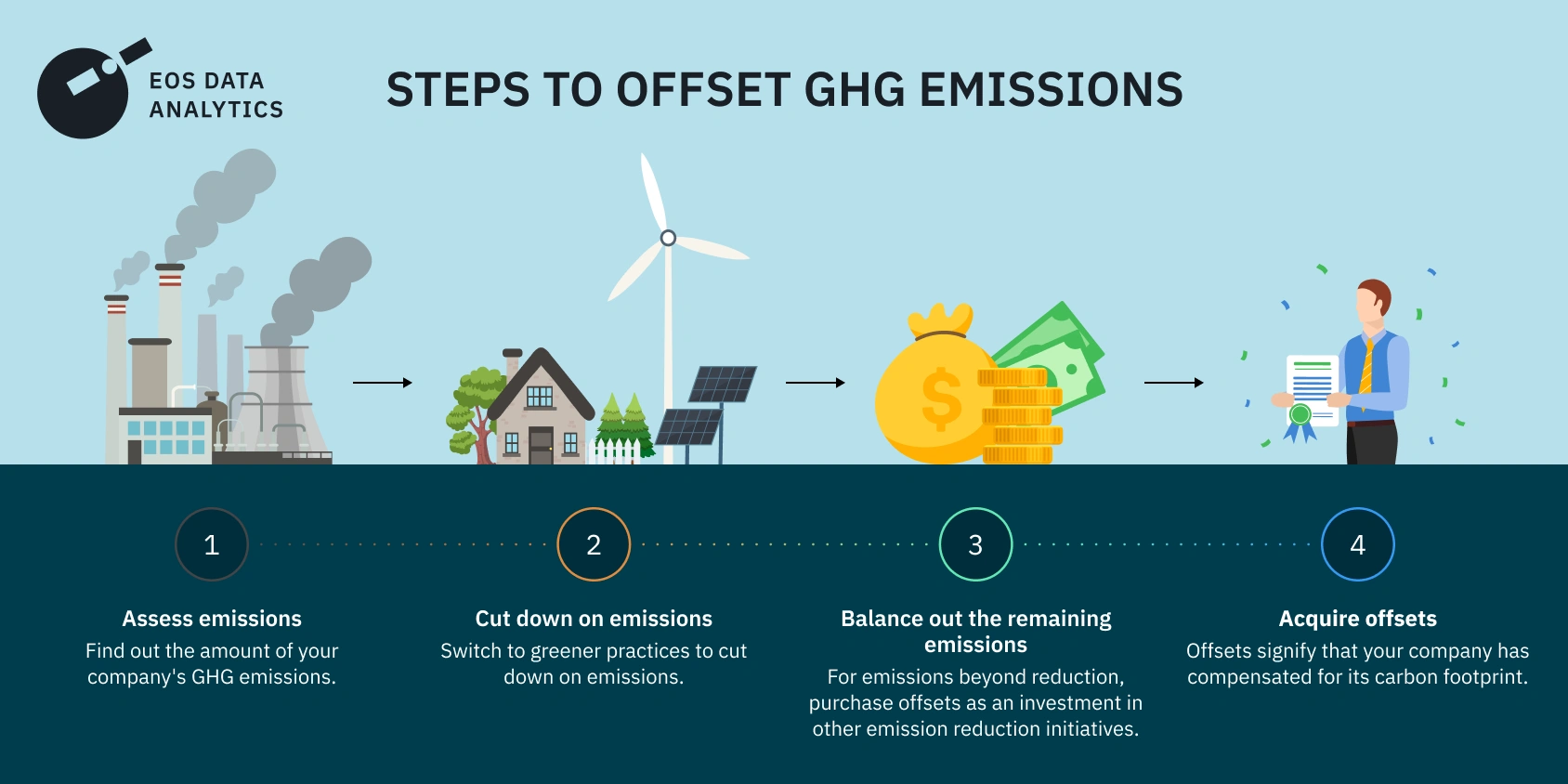
Carbon emission offset provides a means of funding for environmental projects that, for various reasons, have a hard time attracting investors. Companies seeking to compensate for their GHG emissions can obtain carbon credits from a number of organizations engaged in sustainability or nature preservation projects.
Credits can be sold in voluntary markets by emission-reducing organizations to companies that are trying to achieve net-zero emissions through carbon offsets. Here are the five most prominent voluntary registries that cater to offsetting purposes:
- Verified Carbon Standard (VCS) Program by Verra;
- Gold Standard;
- Climate Action Reserve;
- Plan Vivo Foundation;
- American Carbon Registry (ACR).
How Does Buying Carbon Offsets Keep CO2 Out Of The Atmosphere?
Greenhouse gas emission offsets are becoming increasingly attractive to governments and corporations as a tool to fight climate change and meet both mandatory and voluntary emission reduction goals. Certain actors, including those in the energy sector, will find it more difficult to support the long-term decarbonization required to achieve these lofty goals. Even so, by purchasing credits, they can make headway immediately. That is why over 50% of the global top 100 corporations have expressed their intention to buy offsetting credits .
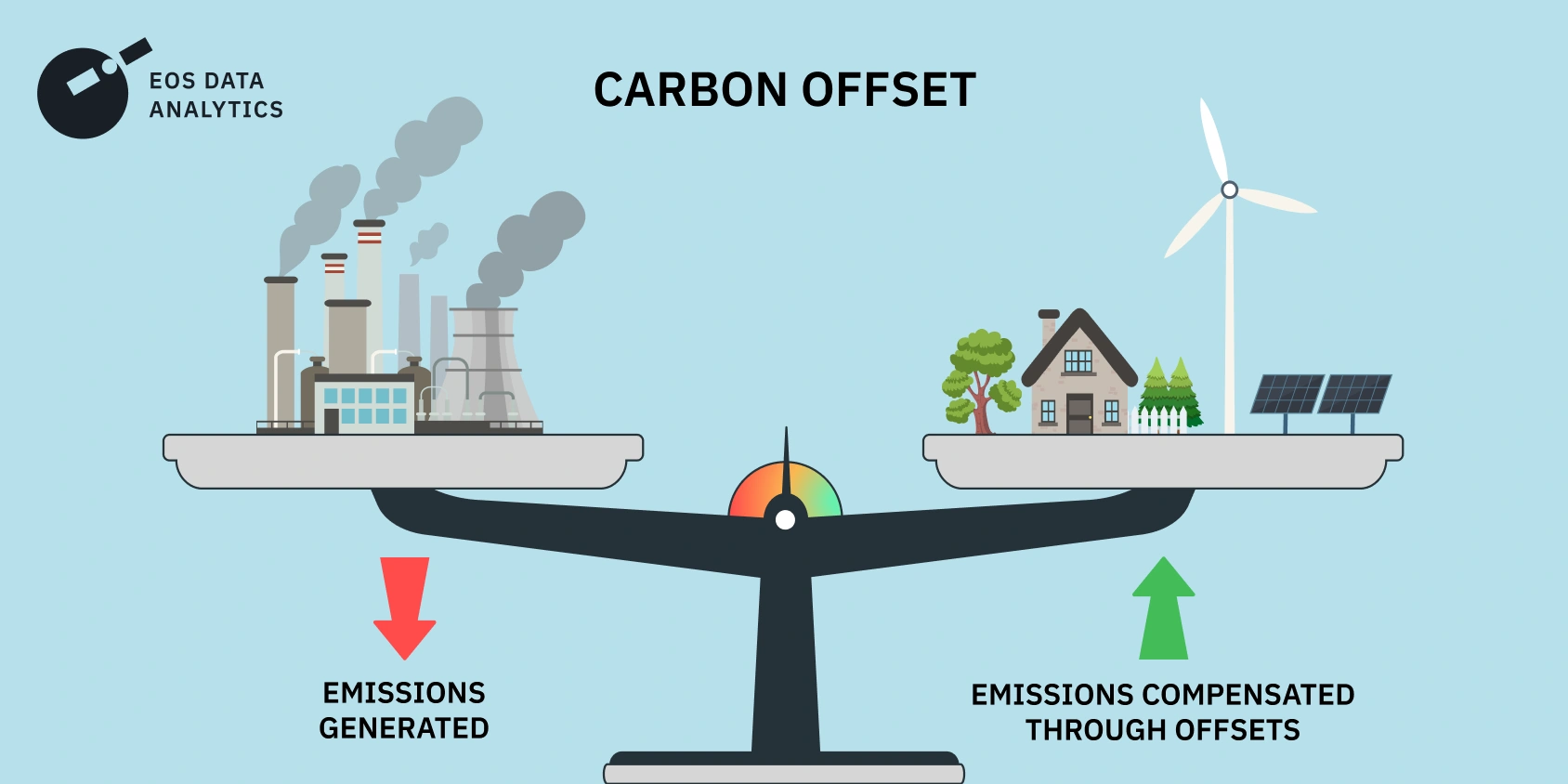
Offsetting the carbon footprint helps provide funding for initiatives aimed at reducing CO2 emissions or removing CO2 from the atmosphere. The type and execution of the initiatives funded through offsetting heavily influence how successful they are in reducing atmospheric CO2 levels. Successful projects often include reforestation and afforestation, the development of renewable energy infrastructure, and carbon farming.
Types Of Carbon Offset Projects
Reducing greenhouse gas emissions isn’t the only benefit most initiatives deliver. Greener energy supply, decreased pollution, increased biodiversity, and ecosystem preservation are other potential benefits that may vary by project type. In this section, we’ll go over the different types of carbon offset projects and the benefits they offer.
Forestry
Projects focusing on reforestation, afforestation, preventing deforestation, and sustainable forestry are widely embraced to counterbalance GHG emissions. Without trees to absorb and store carbon, atmospheric CO2 levels would be higher, exacerbating global warming. EOSDA forestry solutions are an insightful instrument for those involved in or interested in investing in forestry carbon offsetting projects.
Agriculture
Approximately 30% of the world’s yearly GHG emissions come from various agricultural activities . Agricultural carbon offsets can drive positive changes in the industry. Methane (CH4) capture, soil carbon sequestration, averted conversion of grassland to cropland, biochar, and agroforestry are the most promising agricultural projects for now.
Renewable Energy
Offsets are crucial for financing renewable energy projects like the construction or upkeep of solar, wind, and hydrogen plants worldwide. In addition to increasing the grid’s renewable energy capacity, investing in these projects generates employment opportunities, lessens dependency on fossil fuels, and backs the sector’s expansion.
Energy Efficiency
Carbon footprint offsetting often takes the form of initiatives to improve energy efficiency. Similar to renewable energy programs, these projects aim to counteract emissions by reducing reliance on so-called “dirty energy” from fossil fuels. They will typically promote the construction of low-energy LEED-certified buildings as well as the replacement of combustion appliances.
Aviation
Passenger flight operations are the most harmful of the many aviation-related activities that release CO2. CORSIA is a major effort to make up for emissions in this sector. With its help, airline companies can offset their carbon footprint by buying and selling credits on the global market .
Water Management
Access to clean water is a major problem for many people living in rural areas, particularly in Africa. Unfortunately, the water they can get is often not fit for human consumption due to pollution or the presence of harmful microorganisms. The only viable option available to the locals for making it slightly safer is to boil it. Projects for improved water management and increased pure water availability result in lower CO2 emissions as less water needs to be boiled.
Waste Management
Solid waste, rather than being a danger to the environment, can be turned into a low-cost source for promoting sustainability. Reducing the negative effects of waste on people, wildlife, and the environment is the primary goal of GHG offsets in waste management. Reducing landfill trash and GHG emissions is a double win from recycling and reusing waste.
Carbon Sequestration
Carbon sequestration offsets rely on a technique to store the gas in locations where it is highly unlikely to be released again. Soil, wetlands, and trees can be used as storage sites for CO2 removed from the atmosphere. For the most part, CO2 emissions are sequestered through land-based biological sinks like forests and crops.
Criteria For High-Quality Carbon Offset Initiatives
To evaluate the quality of a carbon-offsetting project, certain parameters should be considered:
- Baseline. Without the project, how many emissions would there be?
- Measurement. What cannot be measured cannot be managed. So, how will emissions be measured during and after the project’s implementation?
- Net positivity. This means that credits are only granted for emission reduction/removal directly attributable to the implementation of the project, which is verified by independent third parties.
- Leakage-free. The project should not lead to emissions in other areas. Here’s an illustration of leakage in carbon offsets: a project protects one forest but leads to further deforestation in another region that is not protected.
- Permanence. For how long will the advantages of the project last? In an ideal scenario, credits would stand for irreversible reductions in emissions.
- Additionality. To understand if there’s additionality in terms of carbon offsets, you should know whether the project depends on funds from selling credits or if it would be implemented anyway (for example, thanks to the savings the project brings).
- Double counting. Is there more than one company or organization claiming this project for offsetting their carbon emissions? It is not feasible to use credits claimed by one entity as a compensation instrument for another.
You can confidently step into the project if you receive satisfactory answers to all the questions.
Benefits And Challenges Of Carbon Offsets
The benefits of balancing out GHG emissions usually surpass the difficulties associated with credit verification and purchasing. Let’s say, a company opts to transition from a carbon-intensive yet cost-effective approach to a carbon-free but pricier alternative. Thanks to the new technology’s ability to reduce CO2 emissions, they can compensate for the higher cost by creating and selling credits. Implementing this approach at the sectoral, regional, or even national scale will help the world reach its emissions targets more cost-effectively.
While offsetting aims to incentivize sustainable practices in agriculture, forestry, and the energy sector, it remains problematic to verify that each specific initiative has a net positive effect on the environment. Credits can only be issued if a project demonstrates a tangible decrease in CO2 emissions. In addition to clearly defined standards, the verification procedure, which is frequently costly and project-specific, requires a reliable method of ensuring that the project is carrying out its stated objectives.
Regrettably, research reveals that sometimes there is “over-crediting” when credits are marketed as achieving greater reductions in emissions than actually occur . But if both developers and consumers act responsibly, carbon offsetting can become a potent tool for combating climate change.
EOSDA’s SOC Solutions For Companies Concerned With Their Environmental Footprint
Developing and choosing the most reliable GHG offsetting projects requires consistent collection and analysis of tons of data. At EOSDA, we have devised methods to streamline this process so that you can put more effort into implementing sustainable practices and less into researching them.
Advanced Soil Organic Carbon (SOC) Modeling
Agribusinesses can benefit from EOSDA’s SOC solution by learning about the current amount of carbon stored on their farmlands and finding ways to sequester more. Our custom solution effectively mingles the best of SOC modeling and satellite technologies for carbon offsetting project developers. By applying our complex algorithms to data obtained from soil tests, we can accurately estimate the SOC storage in your fields. To account for differences in climate and terrain, our models harness up to 140 predictors.
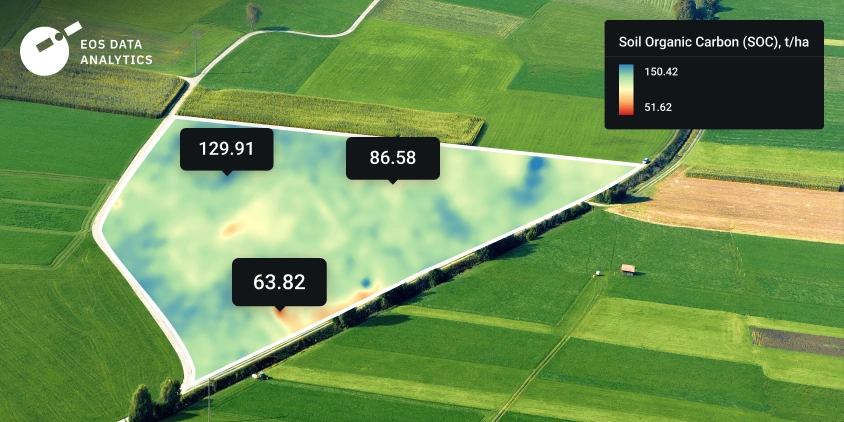
Long-Range Forecasting Of Carbon Sequestered
Using the revered RothC model, which sees extensive application by the FAO, we present a novel approach to forecasting SOC levels over a chosen time frame, ranging from three months to a few years. By predicting the amount of SOC, project developers can estimate their potential carbon credit generation. This information helps zero in on sustainable activities and choose the best carbon-reduction strategy. Governments and NGOs may also benefit from forecasting when researching climate hazards and GHG-related topics.
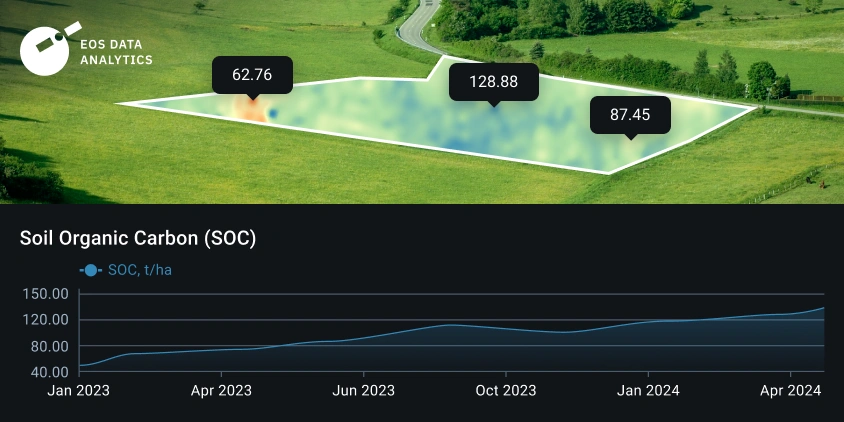
Spending Less On Soil Sampling
Our technology allows customers to efficiently collect soil samples on a broader grid, resulting in a 90% reduction in sample counts from the second sampling onward. Given their extensive land holdings, large-scale farmers and agricultural cooperatives will be able to reinvest their significant savings on soil testing in more sustainable practices, such as regenerative agriculture, creating a positive feedback loop.
How Do Carbon Offsets Help The Environment?
In the fight against climate change, offsetting is useful, but it is far from the only option. With offsetting, polluters are not immediately compelled to reduce their GHG production; instead, they can pay others to do so. Offsetting credits, however, do push for better carbon-related policies and their implementation in previously unaddressed areas. Offsetting will significantly improve our chances of mitigating climate change once big emitters commit to becoming carbon-neutral.
Our custom solutions for carbon offset projects empower businesses to make a positive impact. By purchasing trustworthy GHG credits and lending your support to meaningful projects, you can contribute to a more sustainable future.
About the author:
Lidiia Lelechenko holds a Master Degree in Viticulture, Winemaking & Marketing obtained in ESA (École supérieure d'agricultures d'Angers). She has over 6 years of experience in various roles related to SaaS solutions sales and research activities in sensory analysis. Currently, Lidiia is responsible for strengthening EOSDA presence and recognition on European markets as an Account Executive.
Recent articles

Analyze 2025 & Plan Your Best Year Yet: LandViewer Christmas Offer
It’s the most wonderful time of the year! The Christmas holidays are here, and so is your chance to analyze 2025 and plan a prosperous 2026 with more affordable Pro plans in LandViewer.

EOSDA Models Climate Change Impact On Sugarcane Yields
EOSDA modeled future temperature, rainfall, and other climate impacts on Veracruz sugarcane. The results help growers plan long-term adaptation strategies, including timing, varieties, and irrigation.

EOSDA LandViewer Black Friday Sale: Exclusive Offers & Giveaway
This Black Friday, LandViewer offers new users the chance to save on monthly plans, get extra months with yearly subscriptions, and participate in a free annual plan giveaway.